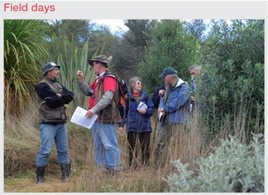Initial spacing in radiata pine
Wink Sutton, New Zealand Tree Grower May 2007.
Recent silvicultural improvements, such as seed source – almost all seed now comes from seed orchards – nursery practice, tree handling, planting methods, weed control and the adoption of regimes that do not include a production thinning, have all reduced initial stocking levels. The initial spacing is now generally determined by how many trees need to be planted to ensure a final crop stocking of high quality stems, for which a ratio of three to one is usually adequate.
Such decisions may appear rational, but the thinking a century ago was very different. The following is my understanding of the evolution of initial spacing approaches and how initial spacing helped our understanding of radiata pine silviculture.
Replicating nature
When the first government plantings began in the late 1890s, the approach to initial spacing was an attempt to replicate nature.
Following European practice trees were closely planted. Although the initial spacing could have been closer, the initial stocking adopted was at a rate of just under 7,000 trees per hectare – which was 1.2 metres or four feet square. The theory was that if trees were planted closely, the trees would grow straight and the lowest branches would soon die and fall off. As in the old growth stands, such trees would produce timber free of knots.
Most of the early plantings were with prison labour, and only a small area could be planted because of the very high stocking, but there would also have been early evidence that very high stocking levels resulted in early tree mortality. By 1910 the initial spacing had been reduced to about 3,000 trees per hectare.
Wider spacing
Soon after the large scale plantings began in the late 1920s the initial spacing was extended to 1.8 by 2.4 metres – approximately 2,200 stems per hectare, and even to 2.4 metres square – approximately 1,700 trees per hectare. Adoption of the wider spacings was to reduce costs and to allow a greater area to be planted with the same resources.
In the late 1930s the initial plantings were harvested. The high initial stocking did not result in natural pruning and produced almost no clearwood. Most of the timber sawn was full of knots, many of them small and bark encased. If we were to produce clearwood, radiata pine had to be artificially pruned.
In the late 1940s and early 1950s a number of initial spacing trials were established in State forests such as Woodhill, Kaingaroa, Gwavas and Eyrewell forests, with spacings ranging from 1.8 metres to 4.8 metres. Some trials included examples of rectangular spacing.
Evaluating spacing
When the ‘economics of silviculture’ group was established in the 1960s I joined the group and my responsibilities included initial spacing. My first approach was to evaluate those NZ Forest Service spacing trials. Measurements of tree diameters, basal area and heights were straight forward but branch measurements were not.
As it did not directly relate to log quality and was dependent on the total number of branches, a measure of average branch size was almost meaningless. Branch measurements were limited to the dominants and larger co-dominants – the trees most likely to be in the final crop. A meaningful and repeatable measure of the average branch size not only proved difficult to relate to log quality but also impossible to assess. Small branches were difficult to count – once trees age small dead branches can be easily broken off or they rot and fall off. As the size of the largest knots was important in determining sawn timber grades, branch measurements were concentrated on the assessment of the largest branches.
Economic evaluation of the initial spacing demonstrated the advantages of a wide spacing. The research also demonstrated the financial advantages of rectangular spacing – lower planting, selection and releasing costs. But do trees planted at rectangular spacing differ in tree form? Measurements in the spacing trials showed that rectangular spacings were not significantly different from their square planting equivalents. Branch sizes between the rows were no smaller than those within the rows.
This uniform development was confirmed by measurements in an unthinned mature radiata pine stand planted at 7.3 by 1.8 metres. The between and within row tree diameters and average largest branch sizes were within one percent of each other.
Initially this was a surprising result but observations in mature radiata pine stands show that radiata pine branches have the ability to grow towards a more open space. Not all tree species appear to have this ability. Douglas fir branches, for example, almost always appear to grow straight out from the stem.
How important is spacing?
Some foresters place considerable emphasis on tree spacing at planting and at thinning for the final crop. However I am yet to be convinced that tree spacing is important. In radiata pine the spacing can vary, perhaps within the range of double and half the specified spacing, a ratio of four to one, with no or little effect on tree growth or form.
My evidence is mostly circumstantial –
- The ability of radiata pine branches to bend towards a light well
- A concerted but wasted research effort trying to demonstrate that a tree’s growth is determined by the size and closeness of its immediate neighbours
- Observations in unthinned mature radiata stands initially planted at 3,000 stems per hectare but with less than 10% of those trees surviving. It was not uncommon to find two large trees just 1.8 metres apart. There were a few examples of three large trees at the same spacing, and I even found one example of four large trees growing at the corners of a 1.8 metre square. If tree spacing was important there is no way these examples could exist.
Provided the overall stocking is as specified the actual spacing of those trees is a minor consideration. The research in the spacing trials was an important contribution to the paper Dr Bob Fenton and I wrote in 1968 advocating a sawlog regime that is similar to that is now practised in many New Zealand plantations.
Wink Sutton is the Patron of the NZFFA
In his excellent 1993 Radiata Pine Growers Manual Piers MacLaren has a very comprehensive discussion on initial spacing. Although spacing was one of my responsibilities when I was with the economics of silviculture team at the Forest Research Institute, I could not add anything substantial to what Piers has written.

 Farm Forestry New Zealand
Farm Forestry New Zealand


No posts yet
Add a post